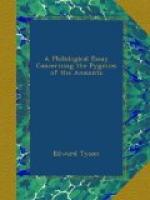For the reasons just enumerated, I am unable to accept Mr. MacRitchie’s theory as a complete explanation of the fairy question, but I am far from desirous of under-estimating the value and significance of his work. Mr. Tylor, as I have already mentioned, states, in a sentence which may yet serve as a motto for a work on the whole question of the origin of the fairy myth, that “various different facts have given rise to stories of giants and dwarfs, more than one mythic element perhaps combining to form a single legend—a result perplexing in the extreme to the mythological interpreter."[A] And I think it may be granted that Mr. MacRitchie has gone far to show that one of these mythic elements, one strand in the twisted cord of fairy mythology, is the half-forgotten memory of skulking aborigines, or, as Mr. Nutt well puts it, the “distorted recollections of alien and inimical races.” But it is not the only one. It is far from being my intention to endeavour to deal exhaustively with the difficult question of the origin of fairy tales. Knowledge and the space permissible in an introduction such as this would alike fail me in such a task. It may, however, be permissible to mention a few points which seem to impress themselves upon one in making a study of the stories with which I have been dealing. In the first place, one can scarcely fail to notice how much in common there is between the tales of the little people and the accounts of that underground world, which, with so many races, is the habitation of the souls of the departed. Dr. Callaway has already drawn attention to this point in connection with the ancestor-worship of the Amazulu.[B] He says, “It may be worth while to note the curious coincidence of thought among the Amazulu regarding the Amatongo or Abapansi, and that of the Scotch and Irish regarding the fairies or ‘good people.’ For instance, the ‘good people’ of the Irish have assigned to them, in many respects the same motives and actions as the Amatongo. They call the living to join them, that is, by death; they cause disease which common doctors cannot understand nor cure; they have their feelings, interests, partialities, and antipathies, and contend with each other about the living. The common people call them their friends or people, which is equivalent to the term abakubo given to the Amatongo. They reveal themselves in the form of the dead, and it appears to be supposed that the dead become ‘good people,’ as the dead among the Amazulu become Amatongo; and in funeral processions of the ‘good people’ which some have professed to see, are recognised the forms of those who have just died, as Umkatshana saw his relatives amongst the Abapansi. The power of holding communion with the ‘good people’ is consequent on an illness, just as the power to divine amongst the natives of this country. So also in the Highland tales, a boy who had been carried away by the fairies, on his return to his own home speaks of them as ’our folks,’ which is




